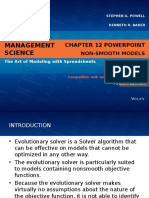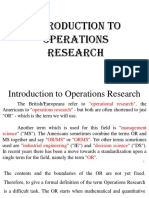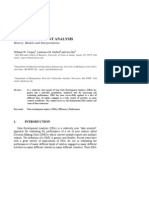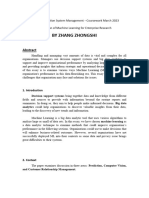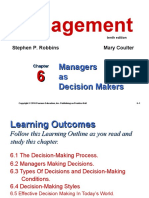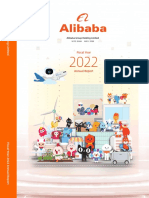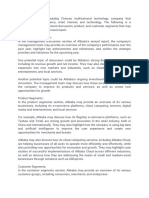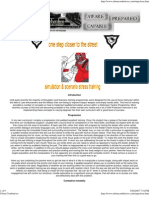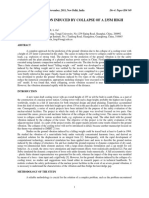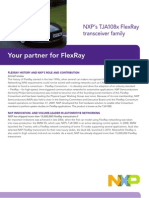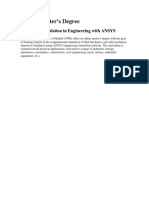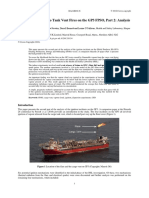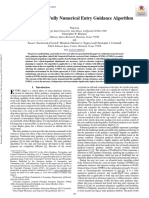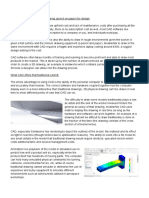100%(1)100% found this document useful (1 vote)
29K views112 pagesChapter 10 Theory With Examples
This document provides an introduction to simulation modeling. It discusses how simulation models incorporate uncertainty into input variables and allow those variables to take on different values to see how outputs vary. The key advantages of simulation models are that they provide a distribution of potential results rather than a single outcome and allow analysis of how sensitive a system is to changes. The document introduces common probability distributions that can be used for random inputs in simulation models, such as discrete, continuous, symmetric, skewed, bounded, and unbounded distributions. It also provides an example to illustrate the "flaw of averages" that can occur when using deterministic rather than simulation modeling.
Uploaded by
Pawan ACopyright
© © All Rights Reserved
We take content rights seriously. If you suspect this is your content, claim it here.
Available Formats
Download as PPTX, PDF, TXT or read online on Scribd
100%(1)100% found this document useful (1 vote)
29K views112 pagesChapter 10 Theory With Examples
This document provides an introduction to simulation modeling. It discusses how simulation models incorporate uncertainty into input variables and allow those variables to take on different values to see how outputs vary. The key advantages of simulation models are that they provide a distribution of potential results rather than a single outcome and allow analysis of how sensitive a system is to changes. The document introduces common probability distributions that can be used for random inputs in simulation models, such as discrete, continuous, symmetric, skewed, bounded, and unbounded distributions. It also provides an example to illustrate the "flaw of averages" that can occur when using deterministic rather than simulation modeling.
Uploaded by
Pawan ACopyright
© © All Rights Reserved
We take content rights seriously. If you suspect this is your content, claim it here.
Available Formats
Download as PPTX, PDF, TXT or read online on Scribd
You are on page 1/ 112
Chapter 10
Introduction to Simulation Modeling
Introduction
• Simulation model is a computer model that
imitates a real-life situation.
• It is like other mathematical models, but it explicitly
incorporates uncertainty in one or more input
variables.
• When you run a simulation, you allow these
random input variables to take on various values,
and you keep track of any resulting output
variables of interest.
• In this way, you are able to see how the outputs
vary as a function of the varying inputs.
Winston/Albright Practical Management Science, 4e South-Western/Cengage Learning
Thomson/South-Western © 2012
2007 ©
Introduction continued
• The fundamental advantage of a simulation model
is that it provides an entire distribution of results,
not simply a single bottom-line result.
• Each different set of values for the uncertain
quantities can be considered a scenario.
• Simulation allows the company to generate many
scenarios, each leading to a particular NPV.
• In the end, it sees a whole distribution of NPVs, not
a single best guess. The company can see what
the NPV will be on average, and it can also see
worst-case and best-case results.
Winston/Albright Practical Management Science, 4e South-Western/Cengage Learning
Thomson/South-Western © 2012
2007 ©
Introduction continued
• These approaches are summarized in the two figures on
the next slide.
• First figure indicates that the deterministic (non-simulation)
approach, using best guesses for the uncertain inputs, is
generally not the appropriate method.
– It leads to the “flaw of averages,” as we will discuss later in
the chapter.
– The problem is that the outputs from the deterministic model
are often not representative of the true outputs.
• The appropriate method is shown second.
– Here the uncertainty is modeled explicitly with random inputs,
and the end result is a probability distribution for each of the
important outputs.
Winston/Albright Practical Management Science, 4e South-Western/Cengage Learning
Thomson/South-Western © 2012
2007 ©
Introduction continued
• Simulation models are also useful for determining how
sensitive a system is to changes in operating conditions.
• A huge benefit of computer simulation is that it enables
managers to answer these types of what-if questions
without actually changing (or building) a physical system.
Winston/Albright Practical Management Science, 4e South-Western/Cengage Learning
Thomson/South-Western © 2012
2007 ©
Introduction continued
• Spreadsheet simulation modeling is quite similar to the
other modeling applications in this book.
– You begin with input variables and then relate these with
appropriate Excel formulas to produce output variables of
interest.
– The main difference is that simulation uses random numbers
to drive the whole process. These random numbers are
generated with special functions that we will discuss in detail.
– Each time the spreadsheet recalculates, all of the random
numbers change.
– This provides the ability to model the logical process once
and then use Excel’s recalculation ability to generate many
different scenarios.
Winston/Albright Practical Management Science, 4e South-Western/Cengage Learning
Thomson/South-Western © 2012
2007 ©
Probability distributions for
input variables
• The primary difference between the spreadsheet
models you have developed so far and simulation
models is that at least one of the input variable
cells in a simulation model contains random
numbers.
• Each time the spreadsheet recalculates, the
random numbers change, and the new random
values of the inputs produce new values of the
outputs. This is the essence of simulation—it
enables you to see how outputs vary as random
inputs change.
Winston/Albright Practical Management Science, 4e South-Western/Cengage Learning
Thomson/South-Western © 2012
2007 ©
Types of probability
distributions
• We begin by adding a few useful probability
distributions to this toolbox.
• However, before adding any specific distributions,
it is useful to provide a brief review of some
important general characteristics of probability
distributions. These include the following
distinctions:
– Discrete versus continuous
– Symmetric versus skewed
– Bounded versus unbounded
– Nonnegative versus unrestricted.
Winston/Albright Practical Management Science, 4e South-Western/Cengage Learning
Thomson/South-Western © 2012
2007 ©
Discrete vs. continuous
• A probability distribution is discrete if it has a finite
number of possible values.
• In contrast, a probability distribution is continuous
if its possible values are essentially some
continuum.
Winston/Albright Practical Management Science, 4e South-Western/Cengage Learning
Thomson/South-Western © 2012
2007 ©
Symmetric vs. skewed
• A probability distribution can either be symmetric or
skewed to the left or right.
• You typically choose between a symmetric and
skewed distribution on the basis of realism.
Winston/Albright Practical Management Science, 4e South-Western/Cengage Learning
Thomson/South-Western © 2012
2007 ©
Bounded vs. unbounded
• A probability distribution is bounded if there are
values A and B such that no possible value can be
less than A or greater than B. The value A is then
the minimum possible value, and the value B is the
maximum possible value.
• The distribution is unbounded if there are no such
bounds.
– Actually, it is possible for a distribution to be bounded in
one direction but not the other.
Winston/Albright Practical Management Science, 4e South-Western/Cengage Learning
Thomson/South-Western © 2012
2007 ©
Nonnegative vs. unrestricted
• One important special case of bounded
distributions is when the only possible values are
nonnegative.
• For example, if you want to model the random cost
of manufacturing a new product, you know for sure
that this cost must be nonnegative.
• There are many other such examples. In such
cases, you should model the randomness with a
probability distribution that is bounded below by 0.
This rules out negative values that make no
practical sense.
Winston/Albright Practical Management Science, 4e South-Western/Cengage Learning
Thomson/South-Western © 2012
2007 ©
Common probability
distributions
• Now that you know the types of probability
distributions available, you can add some common
probability distributions to your toolbox.
• The file Probability Distributions.xlsx was
developed to help you learn and explore these.
• Each sheet in this file illustrates a particular
probability distribution.
• It is important to realize that each of the following
distributions is really a family of distributions.
• Each member of the family is specified by one or
more parameters.
Winston/Albright Practical Management Science, 4e South-Western/Cengage Learning
Thomson/South-Western © 2012
2007 ©
Simulation and the flaw of
averages
• To help motivate simulation modeling in general,
we present a simple example in this section.
• It will clearly show the distinction between a
deterministic model with best-guess inputs and an
appropriate simulation model.
• In doing so, it will illustrate a pitfall called the “flaw
of averages” that you should always try to avoid.
Winston/Albright Practical Management Science, 4e South-Western/Cengage Learning
Thomson/South-Western © 2012
2007 ©
Example 10.1:
Background information
• In August, Walton Bookstore must decide how many of next
year’s nature calendars to order.
• Each calendar costs the bookstore $7.50 and is sold for
$10.
• After January 1 all unsold calendars are returned to the
publisher for a refund of $2.50 per calendar.
• Walton believes that the number of calendars it can sell by
January 1 follows some probability distribution with mean
200.
• Walton believes that ordering to the average demand, that
is, ordering 200 calendars, is a good decision. Is it?
Winston/Albright Practical Management Science, 4e South-Western/Cengage Learning
Thomson/South-Western © 2012
2007 ©
Example 10.1 continued:
A deterministic model
• This model shows that the company’s best profit is $500.
• Do you believe that the average profit will be
• $500 when uncertainty in demand is introduced explicitly (and the
company still orders 200 calendars)? Think what happens to profit
when demand is less than 200 and when it is greater than 200. Are
these two cases symmetric?
Winston/Albright Practical Management Science, 4e South-Western/Cengage Learning
Thomson/South-Western © 2012
2007 ©
Example 10.1 continued:
A simulation model
• We now contrast this with a simulation model where
the demand in cell B9 is replaced by a random
number.
• For this example, we assume that demand is normally
distributed with mean 200 and standard deviation 40,
although these specific assumptions are not crucial for
the qualitative aspects of the example. All you need to
do is enter the formula
=ROUND(RISKNORMAL(200,40),0) in cell B9, where
the ROUND function has been used to round to the
nearest integer. Now the model appears on the next
slide.
Winston/Albright Practical Management Science, 4e South-Western/Cengage Learning
Thomson/South-Western © 2012
2007 ©
Example 10.1 continued:
A simulation model
Winston/Albright Practical Management Science, 4e South-Western/Cengage Learning
Thomson/South-Western © 2012
2007 ©
Example 10.1 continued:
A simulation model
• The point of this simple example is that a
deterministic model can be very misleading.
• In particular, the output from a deterministic model
that uses best guesses for uncertain inputs is not
necessarily equal to, or even close to, the average
of the output from a simulation.
• This is exactly what “the flaw of averages” means.
Winston/Albright Practical Management Science, 4e South-Western/Cengage Learning
Thomson/South-Western © 2012
2007 ©
Simulation with built-in Excel
tools
• In this section, we show how spreadsheet
simulation models can be developed and analyzed
with Excel’s built-in tools without using add-ins.
• To illustrate the Excel-only procedure, we continue
analyzing the calendar problem from Example
10.1. This general problem occurs when a
company (such as a news vendor) must make a
one-time purchase of a product (such as a
newspaper) to meet customer demands for a
certain period of time.
Winston/Albright Practical Management Science, 4e South-Western/Cengage Learning
Thomson/South-Western © 2012
2007 ©
Example 10.2:
Background information
• Walton believes that the number of calendars it
can sell by February 1 follows this probability
distribution.
• Walton wants to develop a simulation model to
help it decide how many calendars to order.
Winston/Albright Practical Management Science, 4e South-Western/Cengage Learning
Thomson/South-Western © 2012
2007 ©
Example 10.2 continued:
Solution
• We first discuss the probability distribution in the
table.
• It is a discrete distribution with only five possible
values: 100, 150, 200, 250 and 300.
• In reality, it is clear that other values of demand are
possible.
• In spite of its apparent lack of realism, we use this
discrete distribution for two reasons.
Winston/Albright Practical Management Science, 4e South-Western/Cengage Learning
Thomson/South-Western © 2012
2007 ©
Example 10.2 continued:
Solution
• First, its simplicity is a nice feature to get us started
with simulation modeling.
• Second, discrete distributions are often used in
real business simulation models.
• Even though discrete distribution is only an
approximation to reality, it can still give us
important insights into the actual problem.
• As for the probabilities in the table, they are
typically drawn from historical data or educated
guesses.
Winston/Albright Practical Management Science, 4e South-Western/Cengage Learning
Thomson/South-Western © 2012
2007 ©
Example 10.2 continued:
Walton Bookstore 2.xlsx
• For any fixed order quantity, we will show how Excel can be
used to simulate 1000 replications (or any other number of
replications).
• Each replication is an independent replay of the events that
occur.
• To illustrate, suppose we want to estimate the expected
profit if Walton orders 200 calendars. To do this we need to
simulate 1000 independent simulations.
• This file contains the setup needed to begin the simulation.
Winston/Albright Practical Management Science, 4e South-Western/Cengage Learning
Thomson/South-Western © 2012
2007 ©
Example 10.2 continued:
Developing the simulation model
• To develop the model, use the following steps.
1. Inputs: Enter the cost data in the range B4:B6, the
probability distribution of demand in the range E5:F9,
and the proposed order quantity, 200, in cell B9.
Columns E and F contain the demand values and the
individual probabilities. It is also convenient to have the
cumulative probabilities in column D. To obtain these,
first enter the value 0 in cell D5. Then enter the formula
=F5+D5 in cell D6 and copy it to the range D7:D9.
2. Generate Random Numbers: Enter a random number
in cell B19 with the formula =RAND( ) and copy it to the
range B20:B1018. Then freeze the random numbers in
this range.
Winston/Albright Practical Management Science, 4e South-Western/Cengage Learning
Thomson/South-Western © 2012
2007 ©
Example 10.2 continued:
Developing the simulation model
3. Generate demands: The key to the simulation is the
generation of the customers demands in the range
B19:B1018 from the random numbers generated by the
RAND function. To do this we:
• Divide the interval from 0 to 1 into five segments. The lengths
of the segments relate to the probabilities of various demands.
• Then we associate a demand with each random number
depending on which interval the random number falls into.
• To implement this procedure, you use a VLOOKUP function
based on the range D5:F9 (named LookupTable).
Winston/Albright Practical Management Science, 4e South-Western/Cengage Learning
Thomson/South-Western © 2012
2007 ©
Example 10.2 continued:
Developing the simulation model
• Enter the formula
=VLOOKUP(B19, LookupTable, 2)
in cell C19 and copy it to the range B20:B1018. The function
compares the random number to the values in D5:D9 and
returns the appropriate demand in E5:E9.
• This step is the key to the simulation, so make sure you
understand what it entails.
Winston/Albright Practical Management Science, 4e South-Western/Cengage Learning
Thomson/South-Western © 2012
2007 ©
Example 10.2 continued:
Developing the simulation model
4. Ordering Cost: The cost of ordering the calendars
does not depend on the demand; it is the unit cost
multiplied by the number ordered. Calculate this in cell
E19 with the formula =Unit_cost*Order_quantity
5. Refund: If the order quantity is greater than the
demand, there is a refund of $2.50 for each calendar
left over, otherwise there is no refund. Therefore, enter
the total refund for the first replication in cell F19 with
the formula =Unit_refund*MAX(Order_quantity-B19,0).
6. Profit: Calculate the profit for this replication in G19
with the formula =C19-E19+D19.
Winston/Albright Practical Management Science, 4e South-Western/Cengage Learning
Thomson/South-Western © 2012
2007 ©
Example 10.2 continued:
Developing the simulation model
7. Copy to other rows: This is a “one-line” simulation,
where all of the logic is captured in a single row, row
19. For one-line simulations, you can replicate the logic
with new random numbers very easily by copying
down. Copy row 19 down to row 1018 to generate 1000
replications.
8. Summary Measures: Each profit value in column G
corresponds to one randomly generated demand. First,
calculate the average and standard deviation of the
1000 profits in cells B12 and B13 with the formulas
=AVERAGE(F19:F1018) and =STDEV(F19:F1018).
Similarly, calculate the smallest and largest profit with
the MIN and MAX functions.
Winston/Albright Practical Management Science, 4e South-Western/Cengage Learning
Thomson/South-Western © 2012
2007 ©
Example 10.2 continued:
Developing the simulation model
9. Confidence Interval for expected profit: Finally, calculate a 95%
confidence interval for the expected profit in cells E13 and E14
with the formulas
=B12-1.96*B13/SQRT(1000)
=B12+1.96*B13/SQRT(1000)
10. Distribution of simulated profits. There are only three possible
profits: –$250, $125, or $500 We can use the COUNTIF function
to count the number of times each of these possible profits is
obtained. To do so, enter the formula
=COUNTIF($F$19:$F$1018,H19) in cell I19 and copy it down to
cell I21.
• At this point we need to look and see what we have
accomplished.
• Let’s look at the results of the simulation.
Winston/Albright Practical Management Science, 4e South-Western/Cengage Learning
Thomson/South-Western © 2012
2007 ©
Example 10.2 continued:
Accomplishments
• So here is what we have accomplished:
– In the body of the simulation rows 19-1018, we randomly generated
1000 possible demands and the corresponding profits.
– Because there are only five possible demand values (100, 150,
200, 250, and 300), there are only five corresponding profit values:
–$250, $125, $500, $500, and $500.
– Also, note that for the order quantity 200, the profit is $500
regardless of whether demand is 200, 250, or 300.
– A tally of the profit values in these rows, including the hidden rows,
indicates that 299 rows have profit equal to –$250 (demand 100),
191 rows have profit equal to $125 (demand 150), and 510 rows
have profit equal to $500 (demand 200, 250, or 300).
– The average of these 1000 profits is $204.13, and their standard
deviation is $328.04.
Winston/Albright Practical Management Science, 4e South-Western/Cengage Learning
Thomson/South-Western © 2012
2007 ©
Example 10.2 continued:
Simulation model
Winston/Albright Practical Management Science, 4e South-Western/Cengage Learning
Thomson/South-Western © 2012
2007 ©
Example 10.2 continued:
Probability distributions
• The probability distribution of profit is as follows:
– P(Profit = -$250) = 316/1000 = 0.316
– P(Profit = -$125) = 185/1000 = 0.185
– P(Profit = -$500) = 499/1000 = 0.499
• We also estimate the mean of this distribution to
be $193.63 and its standard deviation to be
$331.68.
• It is important to be aware that with computer
simulation each time it is run the answers will be
slightly different. This is the reason for the
confidence interval.
Winston/Albright Practical Management Science, 4e South-Western/Cengage Learning
Thomson/South-Western © 2012
2007 ©
Example 10.2 continued:
Confidence intervals
• The confidence intervals can be found in cells E13
and E14.
• This interval expresses our uncertainty about the
mean of the profit distribution.
• Our best guess is the value we observed but
because the corresponding confidence interval is
very wide, from $173.07 to $214.18, we are not
sure of the true mean of the profit distribution.
Winston/Albright Practical Management Science, 4e South-Western/Cengage Learning
Thomson/South-Western © 2012
2007 ©
Example 10.2 continued:
Confidence intervals
• It is common in computer simulation to estimate
the mean of some distribution by the average of
1000 profits.
• The usual practice is then to accompany this
estimate with a confidence interval, which
indicates the accuracy of the estimate.
• You might recall from statistics that to obtain a
confidence interval for the mean, you start with the
estimated mean and then add and subtract a
multiple of the standard error of the estimated
mean.
Winston/Albright Practical Management Science, 4e South-Western/Cengage Learning
Thomson/South-Western © 2012
2007 ©
Example 10.2 continued:
Finding the best order quantity
• So far we have ran the simulation for only a single
order quantity, 200.
• Walton’s ultimate goal is to find the best order
quantity - that is, the order quantity that maximizes
the mean profit.
• This goal can be achieved by using a data table to
rerun the simulation for other order quantities. The
data table can be found in the Walton Bookstore
2.xlsx file.
Winston/Albright Practical Management Science, 4e South-Western/Cengage Learning
Thomson/South-Western © 2012
2007 ©
Example 10.2 continued:
Using the data table
• To form this table, enter the trial order quantities in
K20:K38, enter the formula =B12 in cell L19, and
select the data table range K19:L28.
Winston/Albright Practical Management Science, 4e South-Western/Cengage Learning
Thomson/South-Western © 2012
2007 ©
Example 10.2 continued:
Results
• An order quantity of 150 appears to maximize
profits in the data.
• However, keep in mind this is a simulation, so that
all of these average profits depend on the
particular random numbers generated.
Winston/Albright Practical Management Science, 4e South-Western/Cengage Learning
Thomson/South-Western © 2012
2007 ©
Example 10.2 continued:
Walton Bookstore 4.xlsx
• This file is setup to illustrate another method that is
more general.
• The other method uses a data table to generate
the replications.
• Through row 19 this file and method are the same.
• The next step, however, is different. We form a
data table in the range A23:B1023 to replicate the
basic simulation 1000 times.
Winston/Albright Practical Management Science, 4e South-Western/Cengage Learning
Thomson/South-Western © 2012
2007 ©
Example 10.2 continued:
Data table method
• In column A we list the replication of numbers, 1-
1000.
• The formula for the data table in cell B23 is =F19.
This copies the profit in the prototype row for use
in the data table.
• Then we use the Data/Table command with any
blank cell as the column input.
• Excel repeats the row 19 calculations 1000 times,
each time with a new random number.
• Each time the profit is reported.
Winston/Albright Practical Management Science, 4e South-Western/Cengage Learning
Thomson/South-Western © 2012
2007 ©
Example 10.2 continued:
Using data table
Winston/Albright Practical Management Science, 4e South-Western/Cengage Learning
Thomson/South-Western © 2012
2007 ©
Example 10.2 continued:
Walton Bookstore 4.xlsx
• To take this one step further, we can use a two-way data
table to see how the profit depends on the order quantity.
• The two-way data table has the replication number down
the side and the possible order quantities along the top.
This file contains the setup of the data table.
• The driving formula is in A23, is again =F19 and the
column input is a blank cell, but this time the row input is
B9.
• The following slide shows the average profit versus order
quantity using a data table.
Winston/Albright Practical Management Science, 4e South-Western/Cengage Learning
Thomson/South-Western © 2012
2007 ©
Example 10.2 continued:
Using a two-way data table
Winston/Albright Practical Management Science, 4e South-Western/Cengage Learning
Thomson/South-Western © 2012
2007 ©
Example 10.2 continued:
Two-way data table results
• After averaging the numbers in each column of the
table, we see that 150 appears to be the best
order quantity again.
• It is also helpful to construct a bar chart of these
averages.
• To see if 150 is really the best, you can keep
pressing F9 and the spreadsheet will recalculate
and so will the output and the bar chart.
Winston/Albright Practical Management Science, 4e South-Western/Cengage Learning
Thomson/South-Western © 2012
2007 ©
@RISK models with a single
random input variable
• In the remainder of this section we illustrate some
of @RISK’s functionality by revisiting the Walton
Bookstore example.
• The development of a simulation model is basically
a two-step procedure.
– The first step is to build the model itself. This step
requires you to enter all of the logic that transforms
inputs (including @RISK functions such as
RISKDISCRETE) into outputs (such as profit).
– However, once this logic has been incorporated, @RISK
takes over in the second step.
Winston/Albright Practical Management Science, 4e South-Western/Cengage Learning
Thomson/South-Western © 2012
2007 ©
Example 10.3:
Background information
• Recall that Walton Bookstore buys calendars for $7.50,
sells them at a regular price of $10, and gets a refund of
$2.50 for all calendars that cannot be sold.
• Walton estimates a triangular probability distribution for
demand, where the minimum, most likely, and maximum
values of demand are 100, 175, and 300, respectively.
• The company wants to use this probability distribution,
together with @RISK, to simulate the profit for any
particular order quantity. It eventually wants to find the best
order quantity.
Winston/Albright Practical Management Science, 4e South-Western/Cengage Learning
Thomson/South-Western © 2012
2007 ©
Example 10.3 continued:
Walton Bookstore 5.xlsx
• The spreadsheet model for profit is essentially the
same as we developed previously without @RISK.
Winston/Albright Practical Management Science, 4e South-Western/Cengage Learning
Thomson/South-Western © 2012
2007 ©
Example 10.3 continued:
Developing the simulation model
• The only new things to be aware of are the
following:
1. Input distribution. To generate a random demand,
enter the formula
=ROUND(RISKTRIANG(E4,E5,E6),0) in cell B13 for
the random demand. This uses the RISKTRIANG
function to generate a demand from the given input
distribution. We also use Excel’s ROUND function to
round demand to the nearest integer.
Winston/Albright Practical Management Science, 4e South-Western/Cengage Learning
Thomson/South-Western © 2012
2007 ©
Example 10.3 continued:
Developing the simulation model
2. Output cell. When we run the simulation, we want @RISK to keep
track of profit. In @RISK’s terminology, we need to designate the
Profit cell, F13, as an output cell. There are two ways to designate
a cell as an output cell.
• One way is to do this is to select cell F13 and then click on the Add
Output button on the @RISK ribbon
• This adds RISKOUTPUT(“label”)+ to the cell’s formula. (Here, “label”
is a name that is used for @RISK’s reports. In this case, it makes
sense to use “Profit” as the label.)
Either way, the formula in cell F13 changes from =C13+E13-D13 to
=RISKOUTPUT(“Profit”)+C13+E13-D13.The plus sign following
RISKOUTPUT does not indicate addition. It is simply @RISK’s way
of indicating that we want to keep track of the value in this cell as
the simulation progresses.
Winston/Albright Practical Management Science, 4e South-Western/Cengage Learning
Thomson/South-Western © 2012
2007 ©
Example 10.3 continued:
Developing the simulation model
3. Summary functions. @RISK provides several
functions for summarizing output values. We illustrate
these in the range B16:B19. They contain the formulas
=RISKMIN(F13), =RISKMAX(F3), =RISKMEAN(F13),
and, =RISKSTDDEV(F13),
=RISKPERCENTILE(F13,0.05),
=RISKPERCENTILE(F13,0.95),
=RISKTARGET(F13,300), and
=RISKTARGET(F13,400). The values in these cells are
not of any use until we run the simulation. However,
after the simulation runs, these formulas capture
summary statistics of profit.
Winston/Albright Practical Management Science, 4e South-Western/Cengage Learning
Thomson/South-Western © 2012
2007 ©
Example 10.3 continued:
Running the simulation
• Now that we have developed the model for
Walton, the rest if straightforward.
• The procedure is always the same. We specify
the simulation settings and the report settings,
and then run the simulation.
1. Simulation settings. We must first tell @Risk how we
want the simulation to be run. To do so, click on the
Simulation Settings button on the @Risk toolbar. Set
Iterations to a number such as 1000. This says that we
want to replicate the simulation 1000 times, each with a
new random demand.
Winston/Albright Practical Management Science, 4e South-Western/Cengage Learning
Thomson/South-Western © 2012
2007 ©
Example 10.3 continued:
Running the simulation
• Set Simulations to 1.
• Click on the “dice” button so that it becomes large.
This button is actually a toggle for what appears on
your worksheet. If it’s orange, the setting is called
“Monte Carlo” and all random cells appear random.
• Many more settings are available by clicking on the
button to the left of the “dice” button. In addition,
more permanent settings can be chosen from
Application Settings under Utilities on the @RISK
ribbon.
Winston/Albright Practical Management Science, 4e South-Western/Cengage Learning
Thomson/South-Western © 2012
2007 ©
Example 10.3 continued:
Running the simulation
2. Run the simulation. To do so, simply click on the Start
Simulation button on the @Risk ribbon. At this point,
@Risk repeatedly generates a random number for
each random input cell, recalculates the worksheet,
keeps track of all output cell values. You can watch the
progress at the bottom left of the screen.
3. Examine the results. The big questions are (1) which
results you want and (2) where you want them. @RISK
provides a lot of possibilities, and we mention only our
favorites.
Winston/Albright Practical Management Science, 4e South-Western/Cengage Learning
Thomson/South-Western © 2012
2007 ©
Example 10.3 continued:
Running the simulation
Winston/Albright Practical Management Science, 4e South-Western/Cengage Learning
Thomson/South-Western © 2012
2007 ©
Example 10.3 continued:
Analyzing the output
• @Risk generates a large number of output
measures. We discuss the most important of these
now.
– Summary Report. You can ask for summary measures
right in your model worksheet by using the @RISK
statistical functions, such as RISKMEAN.
– The quickest way to get results is to select an input or
output cell and then click the Browse Results button on
the @RISK toolbar.
Winston/Albright Practical Management Science, 4e South-Western/Cengage Learning
Thomson/South-Western © 2012
2007 ©
Example 10.3 continued:
Discussion of simulation results
– The strength of @RISK is that it keeps track of any
outputs you specify and then allows you to show the
corresponding results as graphs or tables, in temporary
windows or in permanent worksheets.
Winston/Albright Practical Management Science, 4e South-Western/Cengage Learning
Thomson/South-Western © 2012
2007 ©
Example 10.3 continued:
@RISK detailed statistics report
Winston/Albright Practical Management Science, 4e South-Western/Cengage Learning
Thomson/South-Western © 2012
2007 ©
Example 10.3 continued:
Discussion of simulation results
• The smallest simulated profit (out of 1000) was -
$235, the largest was $500, the average was
$337.51, and the standard deviation of the 1000
profits was $189.06.
• The profit distribution, for this particular order
quantity, is extremely skewed to the left, with a
large bar at $500. Do you see why? It’s because
profit is exactly $500 if demand is greater than or
equal to the order quantity, 200. In other words, the
probability that profit is $500 equals the probability
that demand is at least 200.
Winston/Albright Practical Management Science, 4e South-Western/Cengage Learning
Thomson/South-Western © 2012
2007 ©
Example 10.3 continued:
Using RISKSIMTABLE
• Walton’s ultimate goal is to choose an order quantity that
provides a large average profit.
• We could rerun the simulation model several times, each
time with a different order quantity in the order quantity cell,
and compare the results.
• However, this has two drawbacks.
– First, it takes a lot of time and work.
– Second, each time we run the simulation, we get a different set of
random demands. Therefore, one of the order quantities could win
the contest just by luck. For a fairer comparison, it would be better
to test each order quantity on the same set of random demands.
Winston/Albright Practical Management Science, 4e South-Western/Cengage Learning
Thomson/South-Western © 2012
2007 ©
Example 10.3 continued:
Walton Bookstore 6.xlsx
• The RISKSIMTABLE function in @Risk enables us
to obtain a fair comparison quickly and easily.
• This file includes the setup for this model.
• The next slide shows the comparison model.
• There are two modifications to the previous model.
– First, we have listed order quantities we want to test in
row 9.
– Second, instead of entering a number in cell B9, we
enter the formula =RISKSIMTABLE(D9:H9).
Winston/Albright Practical Management Science, 4e South-Western/Cengage Learning
Thomson/South-Western © 2012
2007 ©
Example 10.3 continued:
Model with a RISKSIMTABLE function
Winston/Albright Practical Management Science, 4e South-Western/Cengage Learning
Thomson/South-Western © 2012
2007 ©
Example 10.3 continued:
Using RISKSIMTABLE
• Note that the list does not need to be entered in
the spreadsheet.
• The model is now set up to run the simulation for
all order quantities in the list.
• To do this, only one setting needs to be changed.
As before, we enter 1000 for the number of
iterations, but this time we enter 5 for the number
of simulations.
Winston/Albright Practical Management Science, 4e South-Western/Cengage Learning
Thomson/South-Western © 2012
2007 ©
Example 10.3 continued:
Using RISKSIMTABLE
• You can select the Profit cell and click on Browse
Results to see a histogram of profits, as shown on
the next slide.
• You can click on the summary button to get the
results from all simulations (also shown on the next
slide)
• You can click on Excel Reports to get any of a
number of reports on permanent worksheets.
Winston/Albright Practical Management Science, 4e South-Western/Cengage Learning
Thomson/South-Western © 2012
2007 ©
Example 10.3 continued:
Using RISKSIMTABLE
Winston/Albright Practical Management Science, 4e South-Western/Cengage Learning
Thomson/South-Western © 2012
2007 ©
Example 10.3 continued:
Using RISKSIMTABLE
• Indeed, much of the appeal of @Risk is that we
can see all of these characteristics – averages,
minimums, maximums, percentiles, charts – and
use them to make informed decisions.
Winston/Albright Practical Management Science, 4e South-Western/Cengage Learning
Thomson/South-Western © 2012
2007 ©
@RISK models with several
random input variables
• We conclude this section with another modification
of the Walton Bookstore example.
• To this point, there has been a single random
variable, demand.
• Often there are several random variables, each
reflecting some uncertainty, and you want to
include each of these in the simulation model.
• The following example illustrates how this can be
done, and it also illustrates a very useful feature of
@RISK, its sensitivity analysis.
Winston/Albright Practical Management Science, 4e South-Western/Cengage Learning
Thomson/South-Western © 2012
2007 ©
Example 10.4:
Background information
• As in the previous example, Walton needs to place
an order for next year’s calendar.
• We continue to assume that the calendars sell for
$10, and customer demand for the calendars at
this price is triangularly distributed with minimum
value, most likely value, and maximum value equal
to 100, 175, and 300.
• However, there are now two other sources of
uncertainty.
Winston/Albright Practical Management Science, 4e South-Western/Cengage Learning
Thomson/South-Western © 2012
2007 ©
Example 10.4 continued:
Background information
• First, the maximum number of calendars Walton’s
supplier can supply is uncertain and is modeled
with a triangular distribution.
• It’s parameters are 125 (minimum), 200 (most
likely), and 250 (maximum). Once Walton places
and order, the supplier will charge $7.50 per
calendar if he can supply the entire Walton order.
Otherwise, he will charge only $7.25 per calendar.
• Second, unsold calendars can no longer be
returned to the supplier for a refund. Instead,
Walton will put them on sale for $5 a piece after
February 1.
Winston/Albright Practical Management Science, 4e South-Western/Cengage Learning
Thomson/South-Western © 2012
2007 ©
Example 10.4 continued:
Background information
• At this price, Walton believes the demand for
leftover calendars is triangularly distributed with
parameters 0, 50, and 75.
• Any calendars still left over, say after March 1, will
be thrown away.
• Walton plans to order 200 calendars and wants to
use simulation to analyze the resulting profit.
Winston/Albright Practical Management Science, 4e South-Western/Cengage Learning
Thomson/South-Western © 2012
2007 ©
Example 10.4 continued:
Solution
• As before, we first need to develop the model.
• Then we can run the simulation with @Risk and
examine the results.
• The completed model appears on the next slide.
• The model itself requires a bit more logic than the
previous Walton model.
Winston/Albright Practical Management Science, 4e South-Western/Cengage Learning
Thomson/South-Western © 2012
2007 ©
Example 10.4 continued:
Walton Bookstore 6.xlsx
• See this file for the model setup.
Winston/Albright Practical Management Science, 4e South-Western/Cengage Learning
Thomson/South-Western © 2012
2007 ©
Example 10.4 continued:
Developing the simulation model
• The model can be developed with the following
steps:
1. Random inputs. There are three random inputs in this
model: the most the supplier can supply Walton, the
customer demand when the selling price is $10, and
the customer demand for sale-price calendars.
Generate these cells in B14, E14, and H14 with the
formulas =ROUND(RiskTrian(I5,I6,I7),0),
=ROUND(RiskTrian(E5,E6, E7),0) and
=ROUND(RiskTrian(F5,F6, F7),0). Note that we
generate the random potential demand for calendars at
the sale price even though there might not be any
calendars left to put on sale.
Winston/Albright Practical Management Science, 4e South-Western/Cengage Learning
Thomson/South-Western © 2012
2007 ©
Example 10.4 continued:
Developing the simulation model
2. Actual supply. The number of calendars supplied to
Walton is the smaller of the number ordered and the
maximum the supplier is able to supply. Calculate this
value in cell C14 with the formula
=MIN(B14,Order_quantity).
3. Order cost. Walton gets the reduced price, $7.25, if
the supplier cannot supply the entire order. Otherwise,
Walton must pay $7.50 per calendar. Therefore
calculate the total order cost in cell C16 with the
formula
=IF(B14>=Order_quantity,Unit_cost_1,Unit_cost2)*C14
Winston/Albright Practical Management Science, 4e South-Western/Cengage Learning
Thomson/South-Western © 2012
2007 ©
Example 10.4 continued:
Developing the simulation model
4. Other quantities. The rest of the model is
straightforward. Calculate the revenue from regular-
price sales in cell F14 with the formula
=Regular_price*MIN(C14,E14). Calculate the number
left over after regular-price sales in cell G14 with the
formula =MAX(C14-E14,0). Calculate the revenue from
sale-price sales in cell I14 with the formula
=Sale_price*MIN(G14,H14). Finally, calculate profit and
designate it as an output cell for @Risk in cell J14 with
the formula =RISKOUTPUT(“Profit” )+F14+I14-D14.
Winston/Albright Practical Management Science, 4e South-Western/Cengage Learning
Thomson/South-Western © 2012
2007 ©
Example 10.4 continued:
Running the simulation
• As always, the next steps are to specify the simulation
settings, specify the report settings and run the simulation.
• When there are several input cells, @Risk generates a
value from each of them independently and calculates the
corresponding profit on each iteration.
• Selected results appear on the next slide.
• They indicate an average profit of $395, a 5th percentile of
$56, a 95th percentile of $528, and a distribution of profits
that is again skewed to the left.
Winston/Albright Practical Management Science, 4e South-Western/Cengage Learning
Thomson/South-Western © 2012
2007 ©
Example 10.4 continued:
Sensitivity analysis
• We now demonstrate a feature of @RISK that is
particularly useful when there are several random
input cells.
• This feature lets us see which of these inputs is most
related to, or correlated with, an output cell.
• To perform this analysis, select the profit cell, J14,
and click on the Browse Results Button. You will see
a histogram of profit in a temporary window, and red
button with the pound sign to select a simulation.
Then click on the “tornado” button (the fifth from the
left) and choose Correlation Coefficients.
Winston/Albright Practical Management Science, 4e South-Western/Cengage Learning
Thomson/South-Western © 2012
2007 ©
Example 10.4 continued:
Sensitivity analysis
• The “regression” option produces similar results,
but we believe the correlation option is easier to
understand.
• This figure shows graphically and numerically how
each of the random inputs correlates with profit –
the higher the correlation, the stronger the
relationship between that input and profit.
• In this sense, we see that the regular-price
demand has by far the strongest effect on profit.
Winston/Albright Practical Management Science, 4e South-Western/Cengage Learning
Thomson/South-Western © 2012
2007 ©
Example 10.4 continued:
Sensitivity analysis
• The other two inputs, maximum supply and sale-
price demand, are not nearly as important because
they are nearly unrelated to profit.
• Identifying important input variables can be
important for real applications.
• If a random input is highly correlated with an
important output, then it might be worth the time
and cost to learn more about this input and
possibly reduce the amount of uncertainty
involving it.
Winston/Albright Practical Management Science, 4e South-Western/Cengage Learning
Thomson/South-Western © 2012
2007 ©
Example 10.4 continued:
Sensitivity analysis
Winston/Albright Practical Management Science, 4e South-Western/Cengage Learning
Thomson/South-Western © 2012
2007 ©
The effects of input distributions
on results
• The randomness in input variables causes the variability in
the output variables. We now briefly explore whether the
choice of input distribution(s) makes much difference in the
distribution of an output variable such as profit.
• This is an important question. If the choice of input
distributions doesn’t matter much, then you do not need to
agonize over this choice.
• However, if it does make a difference, then you have to be
more careful about choosing the most appropriate input
distribution for any particular situation. Unfortunately, it is
impossible to answer the question definitively.
Winston/Albright Practical Management Science, 4e South-Western/Cengage Learning
Thomson/South-Western © 2012
2007 ©
The effects of input distributions
on results continued
• We discuss two types of sensitivity analysis in this
section. First, we check whether the shape of the
input distribution matters. In the Walton Bookstore
example, we assumed a triangularly distributed
demand with some skewness.
• Are the results basically the same if a symmetric
distribution such as the normal distribution is used
instead?
Winston/Albright Practical Management Science, 4e South-Western/Cengage Learning
Thomson/South-Western © 2012
2007 ©
The effects of input distributions
on results continued
• Second, we check whether the independence of
input variables that have been assumed implicitly
to this point is crucial to the output results. Many
random quantities in real situations are not
independent; they are positively or negatively
correlated.
• Fortunately, @RISK enables you to build
correlation into a model. We analyze the effect of
this correlation.
Winston/Albright Practical Management Science, 4e South-Western/Cengage Learning
Thomson/South-Western © 2012
2007 ©
Example 10.5 continued:
Background information
• We continue to explore the demand for calendars
at Walton Bookstore.
• We keep the same unit cost, unit price, and unit
refund for leftovers as in Example 11.2.
• However, in that example, we used a triangular
distribution for demand with parameters 100, 175,
and 300.
• Assuming that Walton orders 200 calendars, is the
distribution of profit affected if we instead use a
normal distribution of demand?
Winston/Albright Practical Management Science, 4e South-Western/Cengage Learning
Thomson/South-Western © 2012
2007 ©
Example 10.5 continued:
Solution
• In this type of analysis, it is important to make a
fair comparison.
• When we select a normal distribution for demand,
we must choose a mean and standard deviation.
Which values should we choose?
• It seems only fair to choose the same mean and
standard deviation that the triangular distribution
has.
Winston/Albright Practical Management Science, 4e South-Western/Cengage Learning
Thomson/South-Western © 2012
2007 ©
Example 10.5 continued:
Solution
• To find the mean and standard deviation for a triangular
distribution with given minimum, most likely, and maximum
values, we can take advantage of@ RISK’s Define
Distributions Window. Select any blank cell, click on the
Define Distribution button, select the triangular distribution,
and enter the parameters 100, 175, and 300.
• The pane on the right indicates that the mean and standard
deviation are 191.67 and 41.248, respectively.
• @RISK allows us to see a comparison of these two
distributions, as seen on the next slide. To get this chart,
click on the Add Overlay button, select the normal
distribution from the gallery, and enter 191.67 and 41.248
as its mean and standard deviation.
Winston/Albright Practical Management Science, 4e South-Western/Cengage Learning
Thomson/South-Western © 2012
2007 ©
Example 10.5 continued:
Triangular and normal distributions for demand
Winston/Albright Practical Management Science, 4e South-Western/Cengage Learning
Thomson/South-Western © 2012
2007 ©
Example 10.5 continued:
Walton Bookstore 8.xlsx
• The logic in this model is almost exactly the same
as before.
• This completed model is shown here.
• This file can be used to develop the model.
Winston/Albright Practical Management Science, 4e South-Western/Cengage Learning
Thomson/South-Western © 2012
2007 ©
Example 10.5 continued:
Developing the simulation model
• A clever use of the RISKSIMTABLE function
allows us to run two simulations at once, one for
the triangular distribution and one for the
corresponding normal distribution.
• The two steps required are as follows:
1. RISKSIMTABLE function. We index the two
distributions as 1 and 2. To indicate that we want to run
the simulation with both of them, enter the formula
=RISKSIMTABLE({1,2}) in cell B11. Note that when we
enter actual numbers in this function, rather than cell
references,@RISK requires us to put curly brackets
around the list of numbers.
Winston/Albright Practical Management Science, 4e South-Western/Cengage Learning
Thomson/South-Western © 2012
2007 ©
Example 10.5 continued:
Developing the simulation model
2. Demand. When the value in cell B11 is 1, we want the
demand distribution to be triangular. When it is 2, we
want the distribution to be normal. Therefore, enter the
formula
=ROUND(IF(B11=1,RISKTRIANG(E4,E5,E6),RISKNO
RMAL(H4,H5)),0) in cell B15. Again, the effect is that
the first simulation uses the triangular distribution; the
second uses the normal distribution.
Winston/Albright Practical Management Science, 4e South-Western/Cengage Learning
Thomson/South-Western © 2012
2007 ©
Example 10.5 continued:
Developing the simulation model
• The only @RISK setting to change is the number
of simulations. It should now be set to 2, the
number of values in the RISKSIMTABLE formula.
Other than this, we run the simulation exactly as
before.
• The comparison is shown numerically and
graphically on the next slide.
• As we see, there is more chance of really low
profits when the demand distribution is normal,
whereas each simulation results in the same
maximum profit.
Winston/Albright Practical Management Science, 4e South-Western/Cengage Learning
Thomson/South-Western © 2012
2007 ©
Example 10.5 continued:
Results summary
Winston/Albright Practical Management Science, 4e South-Western/Cengage Learning
Thomson/South-Western © 2012
2007 ©
Example 10.5 continued:
Developing the simulation model
• Both of these statements make sense.
• The normal distribution, being unbounded on the
left, allows for very low demands, and these
occasional low demands result in very low profits.
• On the other side, Walton’s maximum profit is $500
regardless of the input distribution.
• This occurs when Walton’s sells all it orders, in
which case excess demand has no effect on profit.
Winston/Albright Practical Management Science, 4e South-Western/Cengage Learning
Thomson/South-Western © 2012
2007 ©
Example 10.5 continued:
Developing the simulation model
• Nevertheless, the profit distribution in this model is
not greatly affected by the choice of demand
distribution, at least not when (1) the candidate
input distributions have the same mean and
standard deviation, and (2) their shapes are not
too dissimilar.
• This general conclusion about insensitivity of
output distributions to shapes of input distributions
probably can be made in many simulation models.
• However, it is always worth checking, as we have
done here, especially if a lot of money is at stake!
Winston/Albright Practical Management Science, 4e South-Western/Cengage Learning
Thomson/South-Western © 2012
2007 ©
Effects of correlated input
variables
• Until now, all of the random numbers generated with
@RISK functions have been probabilistically independent.
• This means, for example, that if a random value in one cell
is much larger than its mean, the random values in other
cells are completely unaffected.
• They are no more likely to be abnormally large or small
than if the first value had been average or below average.
Sometimes, however, independence is unrealistic. In such
cases, the random numbers should be correlated in some
way.
Winston/Albright Practical Management Science, 4e South-Western/Cengage Learning
Thomson/South-Western © 2012
2007 ©
Effects of correlated input
variables
• As an example, you might expect daily stock price
changes for two companies in the same industry to
be positively correlated.
• If the price of one oil company increases, you
might expect the price of another oil company to
increase as well.
• @RISK enables you to build in this correlated
behavior with the RISKCORRMAT function, as we
illustrate in the following continuation of the Walton
example.
Winston/Albright Practical Management Science, 4e South-Western/Cengage Learning
Thomson/South-Western © 2012
2007 ©
Example 10.6:
Correlated demands
• Suppose that Walton Bookstore must order two
different calendars.
• To simplify the example, we assume that the
calendars each have the same unit cost, unit
selling price, and unit refund value as in previous
examples.
• Also, we assume that each has a triangularly
distributed demand with parameters 100, 175, and
300.
Winston/Albright Practical Management Science, 4e South-Western/Cengage Learning
Thomson/South-Western © 2012
2007 ©
Example 10.6 continued:
Background information
• However, we now assume they are “substitute”
products, so that their demands are negatively
correlated.
• This simply means that if a customer buys one, the
customer is not likely to buy the other.
• Specifically, we assume a correlation of -0.9
between the two demands. How do these
correlated inputs affect the distribution of profit, as
compared to the situation where the demands are
uncorrelated (correlation 0) or very positively
correlated
Winston/Albright
(correlation 0.9)?
Practical Management Science, 4e South-Western/Cengage Learning © 2012
Thomson/South-Western 2007 ©
Example 10.6 continued:
Solution
• The key to building in correlation is @RISK’s
RISKCORRMAT (correlation matrix) function.
• To use this function, you must include a correlation
matrix in the model, as shown in the range J5:K6
of Figure 10.48. (See the file Walton Bookstore
9.xlsx.)
Winston/Albright Practical Management Science, 4e South-Western/Cengage Learning
Thomson/South-Western © 2012
2007 ©
Example 10.6 continued:
Solution
Winston/Albright Practical Management Science, 4e South-Western/Cengage Learning
Thomson/South-Western © 2012
2007 ©
Example 10.6 continued:
Solution
• A correlation matrix must always have 1s along its
diagonal (because a variable is always perfectly
correlated with itself) and the correlations between
variables elsewhere.
• Also, the matrix must be symmetric, so that the
correlations above the diagonal are a mirror image
of those below it.
• Alternatively, @RISK allows you to enter the
correlations only below the diagonal, or only above
the diagonal, and it then infers the mirror images.)
Winston/Albright Practical Management Science, 4e South-Western/Cengage Learning
Thomson/South-Western © 2012
2007 ©
Example 10.6 continued:
Solution
• To enter random values in any cells that are
correlated, you start with a typical @RISK formula,
such as =RISKTRIANG(E4,E5,E6). Then you add
an extra argument, the RISKCORRMAT function,
as follows:
=RISKTRIANG(E4,E5,E6,RISKCORRMAT(J5:K6,1))
• The first argument of the RISKCORRMAT function
is the correlation matrix range. The second is an
index of the variable. In this example, the first
calendar demand has index 1 and the second has
index 2.
Winston/Albright Practical Management Science, 4e South-Western/Cengage Learning
Thomson/South-Western © 2012
2007 ©
Example 10.6 continued:
Developing the simulation model
• Armed with this knowledge, the simulation model on the
next slide is straightforward and can be developed as
follows:
1. Inputs. Enter the inputs in the blue ranges in columns B
and E.
2. Correlation matrix. For the correlation matrix in the range
J5:H6, enter 1s on the diagonal, and enter the formula
=J6 in cell K5 (or leave cell K5 blank). Then enter the
formula =RISKSIMTABLE(I9:K9) in cell J6. This allows
you to simultaneously simulate negatively correlated
demands, uncorrelated demands, and positively
correlated demands.
Winston/Albright Practical Management Science, 4e South-Western/Cengage Learning
Thomson/South-Western © 2012
2007 ©
Example 10.6 continued:
Developing the simulation model
3. Order quantities. Assume for now that the company orders the
same number of each calendar, 200, so enter this value in cells
B9 and B10. However, the simulation is set up so that you can
experiment with any order quantities in these cells, including
unequal values.
4. Correlated demands. Generate correlated demands by
entering the formula
=ROUND(RISKTRIANG(E4,E5,E6,RISKCORRMAT(J5:K6,1)),0
) in cell B14 for demand 1 and the formula
=ROUND(RISKTRIANG(E4,E5,E6,
RISKCORRMAT(J5:K6,2)),0) in cell B15 for demand 2. The
only difference between these is the index of the variable being
generated. The first has index 1; the second has index 2.
Winston/Albright Practical Management Science, 4e South-Western/Cengage Learning
Thomson/South-Western © 2012
2007 ©
Example 10.6 continued:
Developing the simulation model
5. Other formulas. The other formulas in rows 14
and 15 are identical to ones developed in
previous examples, so they aren’t presented
again here. The quantities in row 16 are simply
sums of rows 14 and 15. Also, the only @RISK
output we designated is the total profit in cell F16,
but you can designate others as output cells if
you like.
Winston/Albright Practical Management Science, 4e South-Western/Cengage Learning
Thomson/South-Western © 2012
2007 ©
Example 10.6 continued:
Running the simulation
• You should set up and run @RISK exactly as
before. For this example, set the number of
iterations to 1000 and the number of simulations to
3 (because three different correlations are being
tested).
Winston/Albright Practical Management Science, 4e South-Western/Cengage Learning
Thomson/South-Western © 2012
2007 ©
Example 10.6 continued:
Discussion of the simulation results
• Selected numerical and graphical results are shown in
Figures 10.49 and 10.50. You will probably be surprised to
see that the mean total profit is the same, regardless of the
correlation.
• This is no coincidence. In each of the three simulations,
@RISK uses the same random numbers but “shuffles”
them in different orders to get the correct correlations.
• This means that averages are unaffected. (The idea is that
the average of the numbers 30, 26, and 48 is the same as
the average of the numbers 48, 30, and 26.)
Winston/Albright Practical Management Science, 4e South-Western/Cengage Learning
Thomson/South-Western © 2012
2007 ©
Conclusion
• Simulation has traditionally not received the
attention it deserves in management science
courses.
• The primary reason for this has been the lack of
easy-to-use simulation software.
• Now, with Excel’s built-in simulation capabilities,
plus powerful and affordable add-ins such as
@RISK, simulation is receiving its rightful
emphasis.
Winston/Albright Practical Management Science, 4e South-Western/Cengage Learning
Thomson/South-Western © 2012
2007 ©
Conclusion continued
• The world is full of uncertainty, which is what
makes simulation so valuable.
• Simulation models provide important insights that
are missing in models that do not incorporate
uncertainty explicitly.
• In addition, simulation models are relatively easy to
understand and develop. Therefore, we suspect
that simulation models (together with optimization
models) will soon be the primary emphasis of
• many management science courses—if they are
not already.
Winston/Albright Practical Management Science, 4e South-Western/Cengage Learning
Thomson/South-Western © 2012
2007 ©
Conclusion continued
• In this chapter we have illustrated the basic ideas
of simulation, how to perform simulation with Excel
built-in tools, and how @RISK greatly enhances
Excel’s basic capabilities.
• In the next chapter we will build on this knowledge
to develop and analyze simulation models in a
variety of business areas.
Winston/Albright Practical Management Science, 4e South-Western/Cengage Learning
Thomson/South-Western © 2012
2007 ©
Summary of key management
science terms
Winston/Albright Practical Management Science, 4e South-Western/Cengage Learning
Thomson/South-Western © 2012
2007 ©
Summary of key Excel terms
Winston/Albright Practical Management Science, 4e South-Western/Cengage Learning
Thomson/South-Western © 2012
2007 ©
End of Chapter 10
You might also like
- System Dynamic Modelling For A Balanced Scorecard A Case StudyNo ratings yetSystem Dynamic Modelling For A Balanced Scorecard A Case Study33 pages
- ARIMA Models for Naira-Dollar Exchange RateNo ratings yetARIMA Models for Naira-Dollar Exchange Rate8 pages
- Strategic Management and Strategic Competitiveness: Michael A. Hitt R. Duane Ireland Robert E. HoskissonNo ratings yetStrategic Management and Strategic Competitiveness: Michael A. Hitt R. Duane Ireland Robert E. Hoskisson12 pages
- Ch12 The Art of Modelling With Spreadsheet100% (1)Ch12 The Art of Modelling With Spreadsheet16 pages
- Decision-Making: The Essence of The Manager's Job100% (1)Decision-Making: The Essence of The Manager's Job53 pages
- Fundamentals of Management: Foundations of Decision Making100% (1)Fundamentals of Management: Foundations of Decision Making39 pages
- Time Series Analysis: 1 Contributed by National Academy of Statistical AdministrationNo ratings yetTime Series Analysis: 1 Contributed by National Academy of Statistical Administration56 pages
- Introduction To Operations and Supply Chain Management100% (1)Introduction To Operations and Supply Chain Management46 pages
- Analysis of Active School Transportation in Hilly Urban Environments A Case Study of Dresden PDFNo ratings yetAnalysis of Active School Transportation in Hilly Urban Environments A Case Study of Dresden PDF14 pages
- Operational Research: DR Anshuli Trivedi I ST Year P.G. NSCB Medical College Jabalpur100% (1)Operational Research: DR Anshuli Trivedi I ST Year P.G. NSCB Medical College Jabalpur21 pages
- Introduction To Business Forecasting and Predictive AnalyticsNo ratings yetIntroduction To Business Forecasting and Predictive Analytics25 pages
- Assignment 1.1 Cyber Security Online SimulationNo ratings yetAssignment 1.1 Cyber Security Online Simulation5 pages
- Strategic Management A Competitive Advantage Approach 15th Edition by Fred R David0% (2)Strategic Management A Competitive Advantage Approach 15th Edition by Fred R David312 pages
- 2021 - Marketing Analytics Herramientas Estadísticas para Marketing y Comportamiento Del Consumidor Usando SPSS - CarvalhoNo ratings yet2021 - Marketing Analytics Herramientas Estadísticas para Marketing y Comportamiento Del Consumidor Usando SPSS - Carvalho211 pages
- MT416 - BCommII - Introduction To Business Analytics - MBA - 10039 - 19 - PratyayDasNo ratings yetMT416 - BCommII - Introduction To Business Analytics - MBA - 10039 - 19 - PratyayDas44 pages
- FIN 640 - Assignment 1 - Part 1 With SolutionsNo ratings yetFIN 640 - Assignment 1 - Part 1 With Solutions17 pages
- Hybrid Strategy, Ambidexterity and Environment - Lapersonne (2015)No ratings yetHybrid Strategy, Ambidexterity and Environment - Lapersonne (2015)12 pages
- Chapter 8 A - Predictive Modeling and AnalysisNo ratings yetChapter 8 A - Predictive Modeling and Analysis61 pages
- Valuation Measuring and Managing The Value of Companies Wiley Finance Unlocked Test BankNo ratings yetValuation Measuring and Managing The Value of Companies Wiley Finance Unlocked Test Bank324 pages
- Highline Class, BI 348: Basic Business Analytics Using Excel Chapter 11: Monte Carlo SimulationNo ratings yetHighline Class, BI 348: Basic Business Analytics Using Excel Chapter 11: Monte Carlo Simulation35 pages
- Simulation: Intro To Management ScienceNo ratings yetSimulation: Intro To Management Science29 pages
- Cellular Automata and GIS Based Landuse Suitability Simulation For Irrigated AgricultureNo ratings yetCellular Automata and GIS Based Landuse Suitability Simulation For Irrigated Agriculture7 pages
- Ground Vibration Induced by Collapse of A 235M High Cooling TowerNo ratings yetGround Vibration Induced by Collapse of A 235M High Cooling Tower8 pages
- Promodel Tutorial 1 (Compatibility Mode)No ratings yetPromodel Tutorial 1 (Compatibility Mode)22 pages
- Financial Modelling of Project Finance Transactions - 1553119075 PDFNo ratings yetFinancial Modelling of Project Finance Transactions - 1553119075 PDF21 pages
- (1992) - MODELS A New Simulation Tool in The EMTP - DubéNo ratings yet(1992) - MODELS A New Simulation Tool in The EMTP - Dubé6 pages
- The Effects of Online Gaming Towards TheNo ratings yetThe Effects of Online Gaming Towards The9 pages
- Course Title: IWCF Level 3 - Well Control TrainingNo ratings yetCourse Title: IWCF Level 3 - Well Control Training1 page
- A Case Study On Building SpecificationsNo ratings yetA Case Study On Building Specifications96 pages
- EBOOK Health Assessment in Nursing Sixth North American Edition Download Full Chapter PDF Docx Kindle100% (57)EBOOK Health Assessment in Nursing Sixth North American Edition Download Full Chapter PDF Docx Kindle61 pages
- Hazards 26 Paper 02 Investigation of Cargo Tank Vent Fires On The gp3 Fpso Part 2 Analysis of Vapour DispersionNo ratings yetHazards 26 Paper 02 Investigation of Cargo Tank Vent Fires On The gp3 Fpso Part 2 Analysis of Vapour Dispersion8 pages
- 5verification of A Fully Numerical Entry Guidance AlgorithmNo ratings yet5verification of A Fully Numerical Entry Guidance Algorithm18 pages
- Escape Rooms As A Clinical Evaluation Method For Nursing StudentsNo ratings yetEscape Rooms As A Clinical Evaluation Method For Nursing Students8 pages
- Improving Power System Dynamics by Series Connected FACTS Controllers TCSCNo ratings yetImproving Power System Dynamics by Series Connected FACTS Controllers TCSC6 pages
- Technical Paper - Modelling Suction Pile Lowering Through The SplashzoneNo ratings yetTechnical Paper - Modelling Suction Pile Lowering Through The Splashzone9 pages
- Sap Bw-Apo System Landscape and Interface Considerations: Global ASAP For BW Accelerator100% (1)Sap Bw-Apo System Landscape and Interface Considerations: Global ASAP For BW Accelerator30 pages










